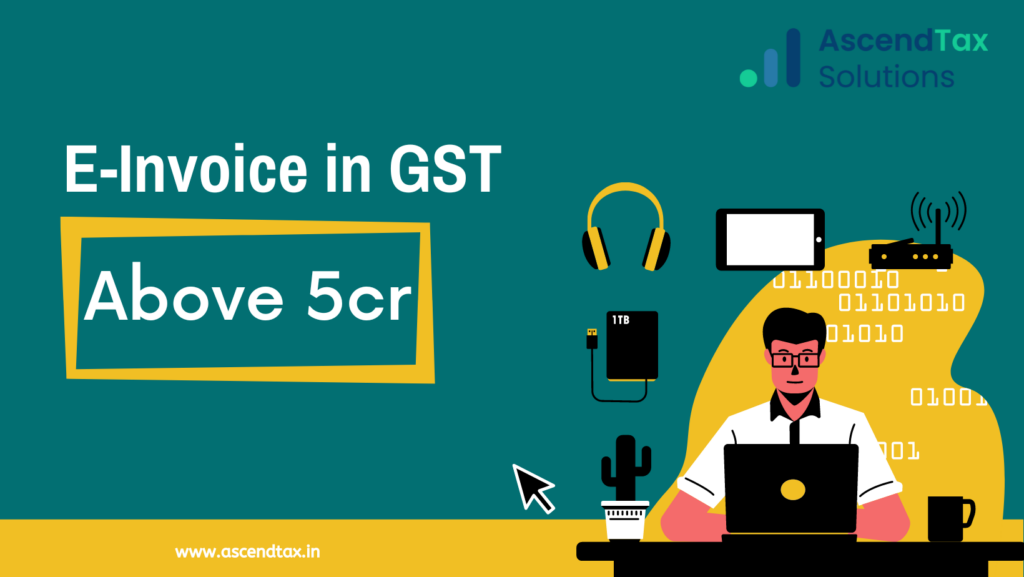A Comprehensive Guide to E-Invoicing under GST for Businesses with Turnover above 5 Crores in any of Preceding Financial Year (From 1st August 2023)

The implementation of e-invoicing under the Goods and Services Tax (GST) regime has brought significant changes to the way businesses generate, report, and manage their invoices. From 01 August 2023, businesses with a turnover exceeding 5 crores in any preceding financial year will be required to comply with e-invoicing provisions. In this article, we will explore the essentials of e-invoicing for such businesses and the impact of this mandate.
What is E-Invoicing?
E-invoicing is a digital process of generating and validating invoices in a standardized format and transmitting them to the GST portal for authentication. The e-invoicing system aims to minimize manual intervention, reduce errors, and promote seamless integration between businesses and the GST system. It will enable businesses to generate invoices using their accounting or billing software, which is compatible with the e-invoicing schema.
Applicability of E-Invoicing
From 01 August 2023, e-invoicing provisions will apply to businesses with a turnover exceeding 5 crores in any preceding financial year. This threshold applies to the aggregate turnover across all registered GSTINs (Goods and Services Tax Identification Numbers) held by a business entity.
Benefits of E-Invoicing
E-invoicing offers several advantages for businesses, including:
a. Automation and accuracy: It minimizes errors, eliminates manual data entry, and reduces the risk of mismatches between invoices and GST returns.
b. Faster processing: E-invoices get authenticated in real-time, enabling faster invoice validation, credit matching, and processing of returns.
c. Improved compliance: E-invoicing ensures compliance with the latest GST regulations, reducing the chances of penalties and fines.
d. Enhanced transparency: The digital trail of e-invoices promotes transparency, making it easier for authorities to track and verify transactions.
Process of E-Invoicing
Under the e-invoicing system, businesses need to generate invoices using their accounting or billing software, which is compatible with the e-invoicing schema. The software then sends the invoice details to the Invoice Registration Portal (IRP), where it gets authenticated and assigned a unique Invoice Reference Number (IRN) and a QR code. Once the invoice is registered, it can be used for further processing, such as filing GST returns.
Exemptions to E-Invoicing
Certain transactions and entities are exempt from e-invoicing requirements. They include:
a. Export invoices: E-invoicing is not mandatory for invoices issued in cases of export transactions.
b. Special Economic Zones (SEZs): Invoices issued by businesses located in SEZs are currently exempt from e-invoicing provisions.
c. Insurance and banking sectors: Insurers, banking companies, and financial institutions are not required to comply with e-invoicing for the time being.
Penalties for Non-Compliance
Non-compliance with e-invoicing provisions can lead to penalties under the GST law. The penalties vary based on the nature and severity of the non-compliance. It is crucial for businesses to ensure timely and accurate adherence to e-invoicing requirements to avoid such penalties.
The e-invoicing mandate for businesses with a turnover exceeding 5 crores from 01 August 2023 is a significant step towards digitizing the GST ecosystem and enhancing compliance. By understanding the fundamentals and complying with the e-invoicing provisions, businesses can streamline their invoicing processes, enhance accuracy, and contribute to a robust and digitized GST ecosystem. It is advisable for businesses to prepare in advance and ensure that their accounting or billing.
